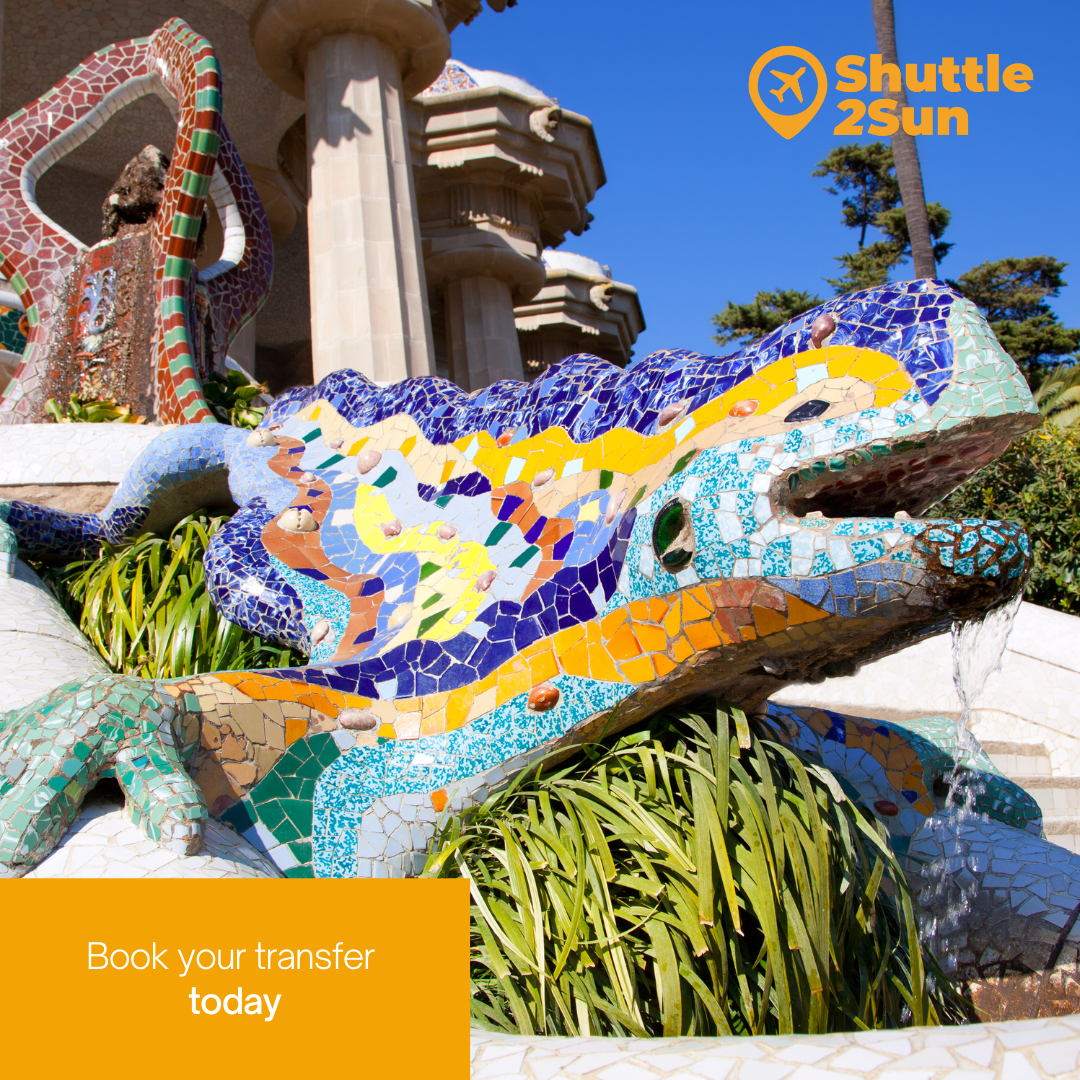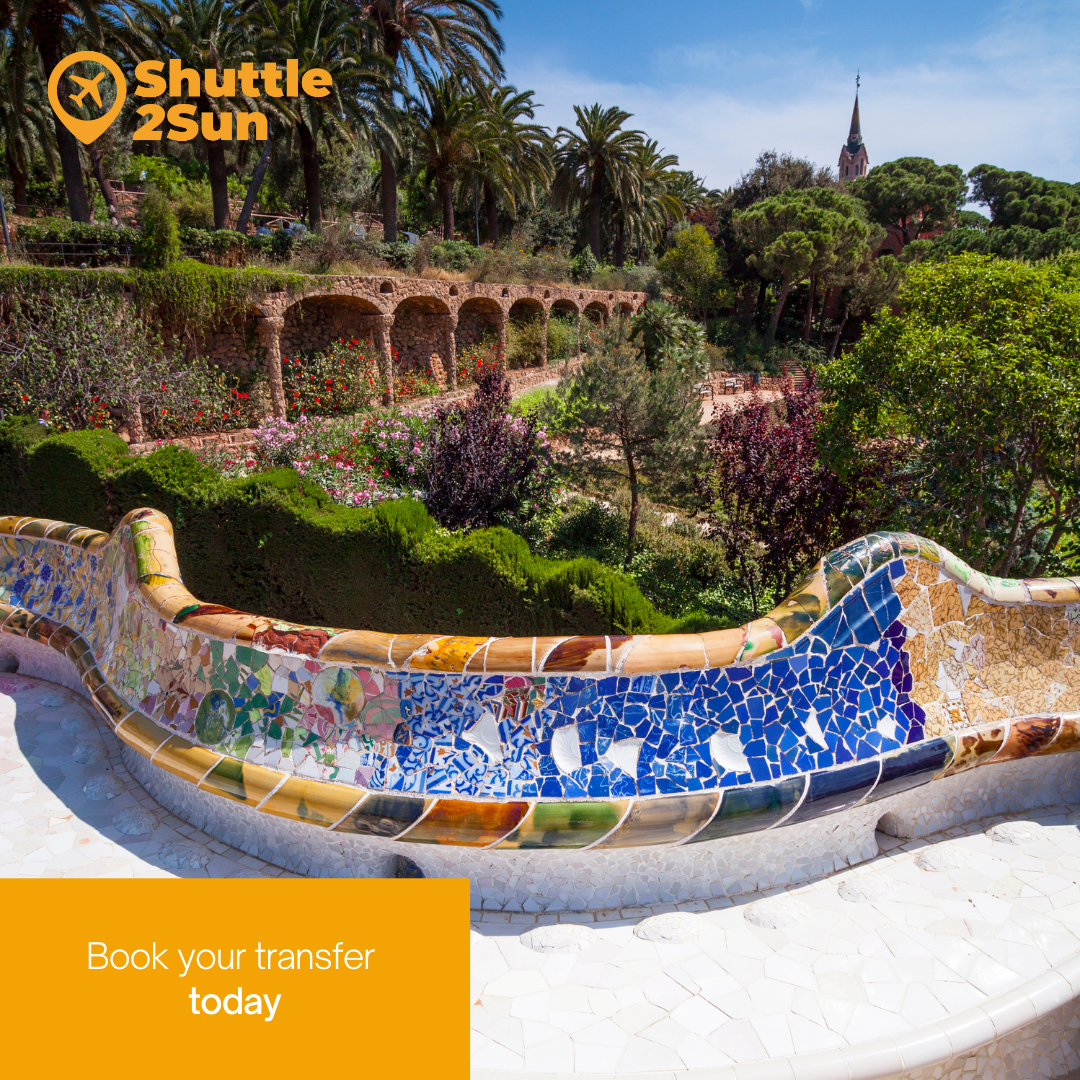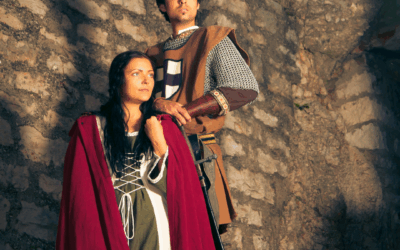Park Güell is one of the most emblematic places in Barcelona, a magical corner that reflects the unparalleled creativity of Antoni Gaudí. Built between 1900 and 1914, this park combines architecture, nature and art in a unique way, making it a symbol of the city and an essential stop for lovers of Modernism.
As well as being a place to stroll through and admire, Park Güell is a window onto Gaudí’s genius and his ability to turn the most innovative ideas into reality. It was declared a World Heritage Site by UNESCO in 1984, reaffirming its importance as an architectural masterpiece.
Dare to uncover each of the secrets and curiosities of Park Güell, moving to Barcelona, with Shuttle2Sun‘s shared transfer services and private transfer services, low-cost and sustainable, from Barcelona airport, Barcelona port, Reus airport, Girona airport and Camp de Tarragona AVE train station.
A park inspired by the fairy tale of Hänsel and Gretel
One of the first impressions of Park Güell is the sensation of having entered a fairy tale. This effect is no coincidence, as Gaudí was inspired by the story of Hänsel and Gretel to design the entrance pavilions to the park. These small houses, decorated with colourful mosaics and candy-like roofs, are reminiscent of the famous chocolate house from the children’s story.
The pavilion on the left, which originally served as a gatehouse, is now an exhibition space on the history of the park. On the other hand, the pavilion on the right, known as the Casa del Guarda, served as a home for the park’s caretaker and is now an extension of the Museum of the History of Barcelona (MUHBA).
The Masons and the symbolism of Park Güell
Park Güell is replete with symbolically charged details, many of which have led to speculation about Antoni Gaudí‘s possible connection to Freemasonry. Although there is no conclusive evidence that the architect was a member of this organisation, several features of the park have fuelled intriguing theories about its link to Masonic ideals.
One of the most striking features is the presence of five-pointed stars scattered throughout the park. For the Freemasons, the number five has a special significance, symbolising the degree of ‘Fellow Worker’, a key stage on the path to knowledge within the brotherhood.

Another Masonic connection is the great central staircase in Park Güell, consisting of 33 steps arranged in three groups of 11. This number, 33, is crucial in Freemasonry, as it represents the highest degree of knowledge and mastery that can be achieved. The Masonic hierarchy is divided into 33 levels, and reaching the last level implies complete mastery of the secrets of the Craft.
Remember that with Shuttle2Sun‘s low-cost and sustainable shared transfer services and private transfer services, you can get to Barcelona from Barcelona Airport, Barcelona Port, Reus Airport, Girona Airport and Camp de Tarragona AVE train station.
Ciutat Jardí: Eusebi Güell’s initial project
Park Güell was born as an ambitious urban planning project promoted by Eusebi Güell, who dreamed of creating a garden city for the Barcelona bourgeoisie. Inspired by the British model of urban development, this residential complex was to have single-family plots surrounded by gardens and nature, in an environment that combined luxury and tranquillity.

Gaudí designed the park’s infrastructure with pathways, squares and communal areas that harmonised with the natural environment. However, the project failed commercially. Finally, Barcelona City Council acquired the land in 1922 and turned it into a public park.
The absence of straight lines in the park
One of the most striking features of Park Güell is the absence of straight lines. Gaudí was a fervent admirer of nature, and in his design he avoided right angles, opting instead for curved, organic forms that imitated the undulations of the land.
From the trencadís benches in the Plaça de la Natura to the spiral paths that run through the park, every detail respects this philosophy. The idea was that the structures would not only blend into their surroundings but also appear as a natural extension of them.
Turó de les Tres Creus, a unique viewpoint
The Turó de les Tres Creus is the highest viewpoint in Park Güell, a place that combines nature and symbolism. At the top are three stone crosses, two of them marking the cardinal points and the third pointing to the sky. Although the construction of the Turó de les Tres Creus was not completed according to the original plans, as Antoni Gaudí wanted to build a chapel there, it is still an emblematic place that invites reflection and enjoyment of the landscape.
The Hypostyle Room
The Hypostyle Room, made up of 86 Doric columns, is not only an architectural masterpiece, but also a practical solution. Inside, these columns conceal an ingenious system that collects rainwater from the square above and channels it into an underground cistern. This underground reservoir is one of the park’s best-kept secrets, with a capacity to store up to 1,200 cubic metres of water.
This system not only prevented flooding but also stored the water for use in irrigating the park, demonstrating Gaudí’s advanced vision in terms of efficiency and care for the environment. In addition, the design of the columns, inclined slightly inwards, gives extra stability to the structure.
Gaudí’s legacy not only transforms Barcelona’s urban landscape but also invites visitors to Park Güell to reflect on the harmony between humanity and nature. With Shuttle2Sun‘s low-cost and sustainable shared transfer services and private transfer services, you can get to Barcelona from Barcelona Airport, Barcelona Port, Reus Airport, Girona Airport and Camp de Tarragona AVE train station.



